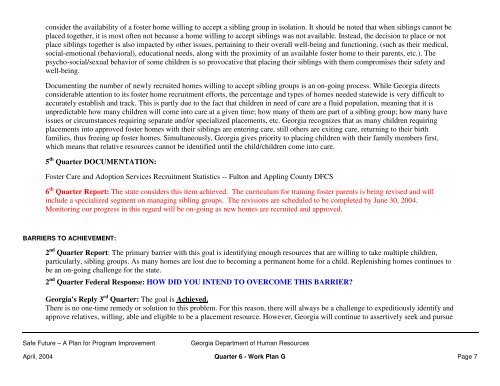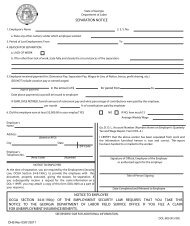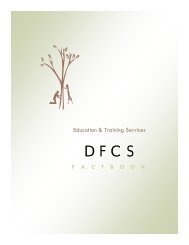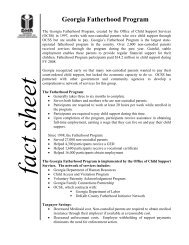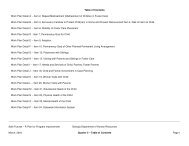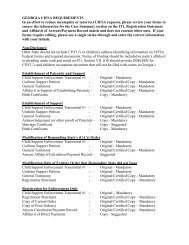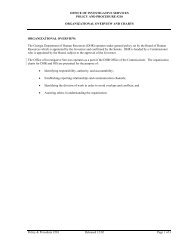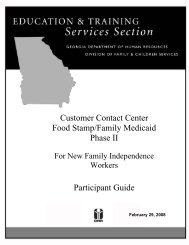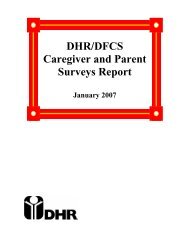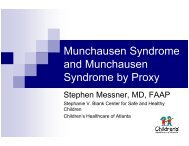Table of Contents - Department of Human Services
Table of Contents - Department of Human Services
Table of Contents - Department of Human Services
Create successful ePaper yourself
Turn your PDF publications into a flip-book with our unique Google optimized e-Paper software.
consider the availability <strong>of</strong> a foster home willing to accept a sibling group in isolation. It should be noted that when siblings cannot be<br />
placed together, it is most <strong>of</strong>ten not because a home willing to accept siblings was not available. Instead, the decision to place or not<br />
place siblings together is also impacted by other issues, pertaining to their overall well-being and functioning, (such as their medical,<br />
social-emotional (behavioral), educational needs, along with the proximity <strong>of</strong> an available foster home to their parents, etc.). The<br />
psycho-social/sexual behavior <strong>of</strong> some children is so provocative that placing their siblings with them compromises their safety and<br />
well-being.<br />
Documenting the number <strong>of</strong> newly recruited homes willing to accept sibling groups is an on-going process. While Georgia directs<br />
considerable attention to its foster home recruitment efforts, the percentage and types <strong>of</strong> homes needed statewide is very difficult to<br />
accurately establish and track. This is partly due to the fact that children in need <strong>of</strong> care are a fluid population, meaning that it is<br />
unpredictable how many children will come into care at a given time; how many <strong>of</strong> them are part <strong>of</strong> a sibling group; how many have<br />
issues or circumstances requiring separate and/or specialized placements, etc. Georgia recognizes that as many children requiring<br />
placements into approved foster homes with their siblings are entering care, still others are exiting care, returning to their birth<br />
families, thus freeing up foster homes. Simultaneously, Georgia gives priority to placing children with their family members first,<br />
which means that relative resources cannot be identified until the child/children come into care.<br />
5 th Quarter DOCUMENTATION:<br />
Foster Care and Adoption <strong>Services</strong> Recruitment Statistics -- Fulton and Appling County DFCS<br />
6 th Quarter Report: The state considers this item achieved. The curriculum for training foster parents is being revised and will<br />
include a specialized segment on managing sibling groups. The revisions are scheduled to be completed by June 30, 2004.<br />
Monitoring our progress in this regard will be on-going as new homes are recruited and approved.<br />
BARRIERS TO ACHIEVEMENT:<br />
2 nd Quarter Report: The primary barrier with this goal is identifying enough resources that are willing to take multiple children,<br />
particularly, sibling groups. As many homes are lost due to becoming a permanent home for a child. Replenishing homes continues to<br />
be an on-going challenge for the state.<br />
2 nd Quarter Federal Response: HOW DID YOU INTEND TO OVERCOME THIS BARRIER?<br />
Georgia's Reply 3 rd Quarter: The goal is Achieved.<br />
There is no one-time remedy or solution to this problem. For this reason, there will always be a challenge to expeditiously identify and<br />
approve relatives, willing, able and eligible to be a placement resource. However, Georgia will continue to assertively seek and pursue<br />
Safe Future – A Plan for Program Improvement<br />
Georgia <strong>Department</strong> <strong>of</strong> <strong>Human</strong> Resources<br />
April, 2004 Quarter 6 - Work Plan G Page 7


